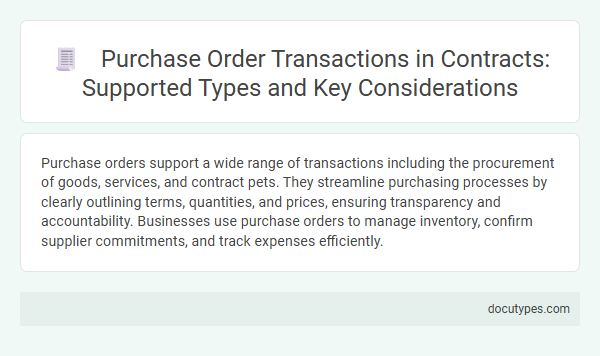Purchase orders support a wide range of transactions including the procurement of goods, services, and contract pets. They streamline purchasing processes by clearly outlining terms, quantities, and prices, ensuring transparency and accountability. Businesses use purchase orders to manage inventory, confirm supplier commitments, and track expenses efficiently.
Introduction to Purchase Order Transactions in Contracts
Purchase order transactions play a crucial role in contract management by formalizing the purchase of goods and services. These transactions support various types, including one-time purchases, recurring orders, and blanket agreements. Understanding how purchase orders operate helps you streamline procurement processes and ensure contract compliance.
Definition and Purpose of Purchase Orders
A purchase order is a formal document issued by a buyer to a seller, outlining the type, quantity, and agreed price for products or services. It serves as a legally binding contract that authorizes the purchase and helps track the order throughout the procurement process. Supported transactions typically include goods procurement, service agreements, and supply chain purchases essential for business operations.
Common Types of Purchase Order Transactions
Purchase orders support a variety of transaction types to streamline procurement processes. Understanding the common types of purchase order transactions helps optimize your purchasing workflow.
- Standard Purchase Order - Used for one-time purchases with fixed quantities and prices.
- Blanket Purchase Order - Covers multiple deliveries over a set period, allowing flexibility in quantity and timing.
- Contract Purchase Order - Establishes terms and conditions for future purchases without specifying quantities upfront.
Supported Purchase Order Types in Contractual Agreements
| Purchase Order Type | Description | Common Use Cases |
|---|---|---|
| Standard Purchase Orders | Used for one-time purchases of goods or services with fixed quantities and prices. | Office supplies, equipment procurement, and single delivery contracts. |
| Blanket Purchase Orders | Support multiple deliveries over a period under one contract with agreed terms and conditions. | Recurring supply of materials, maintenance services, and long-term vendor agreements. |
| Contract Purchase Orders | Linked to a standing contract, authorizing purchases as per pre-negotiated terms. | Large scale projects, multi-phase equipment acquisition, and framework contracts. |
| Planned Purchase Orders | Set expected delivery schedules with estimated quantities, flexible modifications allowed. | Manufacturing supply chains, phased stock replenishment, and seasonal product ordering. |
| Service Purchase Orders | Designed for procurement of services rather than goods, specifying scope and duration. | Consulting, IT services, facility management contracts. |
You can leverage these supported purchase order types in contractual agreements to streamline procurement, ensuring clarity and enforceability in your transactions.
Key Legal Considerations for PO Transactions
What types of transactions are supported by a purchase order? A purchase order typically supports transactions involving the procurement of goods and services between a buyer and a seller. It legally binds the parties to the agreed terms, quantities, prices, and delivery schedules.
What are the key legal considerations for purchase order transactions? The main legal considerations include clear identification of the parties, detailed description of the products or services, and defined payment and delivery terms. Compliance with contract law principles and applicable regulatory requirements ensures enforceability and risk mitigation.
Payment Terms and Milestones in Purchase Orders
Purchase orders support various transaction types including product acquisitions, service agreements, and subscription contracts. These documents specify payment terms to ensure clear expectations between the buyer and supplier.
Payment terms often include deadlines, partial payments, or milestones that trigger payment releases. Your purchase order may define milestones linked to project phases or delivery schedules to facilitate smooth financial transactions.
Risk Allocation and Liability in PO Contracts
A purchase order supports various transaction types including goods procurement, service agreements, and subcontracting arrangements. Understanding risk allocation and liability provisions in these contracts is essential to protect Your interests and ensure clear responsibility delineation.
- Goods Procurement Transactions - Purchase orders specify quality standards and delivery deadlines, allocating risk of loss typically to the supplier until the goods reach the buyer.
- Service Agreement Transactions - Service contracts under purchase orders define the scope of work and liability for performance failures, often including indemnity clauses for risk mitigation.
- Subcontracting Transactions - Purchase orders manage liability by assigning responsibility for subcontractors' actions and clarifying risk transfer conditions to prevent disputes.
Compliance and Regulatory Requirements
Purchase orders support a wide range of transactions including goods procurement, service contracts, and licensing agreements. They ensure compliance with industry regulations by formalizing purchase details and establishing clear contractual obligations.
Purchase orders help maintain regulatory compliance by documenting transaction terms such as pricing, delivery schedules, and payment conditions. Your organization can track and verify purchases against legal standards, reducing the risk of fraud or non-compliance. This structured approach meets audit requirements and supports transparent reporting in regulated industries.
Best Practices for Managing Purchase Order Transactions
Purchase orders support a variety of transactions including goods procurement, service agreements, and inventory replenishment. These documents serve as formal contracts that outline quantities, pricing, and delivery terms.
Best practices for managing purchase order transactions involve accurate record-keeping and timely communication with suppliers. Regular audit trails and validation processes help ensure compliance and reduce discrepancies.
What Types of Transactions Are Supported by a Purchase Order? Infographic

